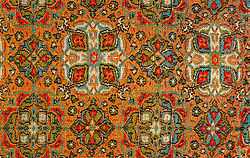Motif (visual arts)

In art, a motif ![]() (pronunciation) (help·info) is an element of a pattern, image or part of one, or theme. A motif may be repeated in a design or composition, often many times, or may just occur once in a work.[1] A motif may be an element in the iconography of a particular subject or type of subject that is seen in other works.
(pronunciation) (help·info) is an element of a pattern, image or part of one, or theme. A motif may be repeated in a design or composition, often many times, or may just occur once in a work.[1] A motif may be an element in the iconography of a particular subject or type of subject that is seen in other works.
Ornamental or decorative art can usually be analysed into a number of different elements, which can be called motifs. These may often, as in textile art, be repeated many times in a pattern. Important examples in Western art include acanthus, egg and dart,[2] and various types of scrollwork.
Many designs in mosques in Islamic culture are motifs, including those of the sun, moon, animals such as horses and lions, flowers, and landscapes. Motifs can have emotional effects and be used for propaganda.[3]
Film
Visual motifs are used in film to establish a mood, such as film noir.[4][5] Blade Runner is a science fiction film that uses visual motifs effectively; director Ridley Scott used a birthing motif in a previous film Alien.[6]
Patterns
-

The Grammar of Ornament Egyptian No 7 (plate 10), image #20 -

Illustration from The Grammar of Ornament (1856) -

Motif in lace -

A Persian motif on textile
-
A Persian motif on textile
-

A Persian motif on textile
-

-

A Persian motif on textile
-

A Persian motif on textile
-

-

A Persian motif on textile
-

A Persian motif on textile
-

A Persian motif on textile
-

A Persian motif on textile
-

A Persian motif on textile
-

A Persian motif on textile
See also
Notes
- ↑ "Art glossary". LatinArt.com. Retrieved December 13, 2011.
- ↑ Lucy T. Shoe, Profiles of Greek Mouldings 1936, supplemented by Shoe, "Greek Mouldings of Kos and Rhodes", Hesperia 19.4 (October - December 1950:338-369 and illustrations)
- ↑ Motifs in Jihadi Internet Propaganda (PDF)
- ↑ (2004) Some Visual Motifs of Film Noir By Alain Silver and James Ursini ISBN 0-87910-197-0
- ↑ (1974) Some Visual Motifs of Film Noir by Janey Place & Lowell Peterson
- ↑ Blade Runner
Further reading
- Hoffman, Richard. Docorative Flower and Leaf Designs. Dover Publications (1991), ISBN 0-486-26869-1
- Jones, Owen. The Grammar of Ornament. Dover Publications, Revised edition (1987), ISBN 0-486-25463-1
- Welch, Patricia Bjaaland. Chinese art: a guide to motifs and visual imagery. Turtle Publishing (2008), ISBN 0-8048-3864-X
